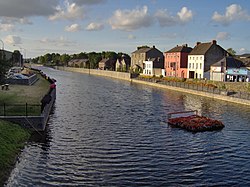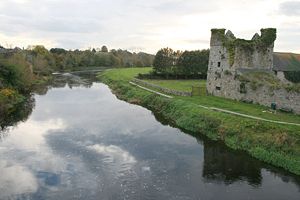River Nore
| River Nore | |
|---|---|
 River Nore in the City of Kilkenny. | |
 Map of the Nore's course | |
| Etymology | Old Irish: Eoir[1] |
| Native name | An Fheoir[2] (Irish) |
| Location | |
| State | Republic of Ireland |
| Region | Leinster |
| Counties | Tipperary, Laois, Kilkenny, Waterford |
| Physical characteristics | |
| Source | Devil's Bit Mountain |
| • location | County Tipperary |
| Mouth | River Barrow |
• location | New Ross, County Wexford |
| Length | 140 km (87 mi) |
| Basin size | 2,595 km2 (1,002 sq mi)[3] |
| Discharge | |
| • average | 42.9 m3/s (1,510 cu ft/s) |
| Basin features | |
| River system | Three Sisters |
| Tributaries | |
| • left | River Suir |
The River Nore (Irish: An Fheoir [ənʲ ˈoːɾʲ])[2] is one of the principal rivers (along with the River Suir and River Barrow) in the South-East Region of Ireland. The 140-kilometre-long (87 mi) river drains approximately 2,530 square kilometres (977 sq mi) of Leinster and Munster,[4][5] that encompasses parts of three counties (Tipperary, Laois, Kilkenny). Along with the River Suir and River Barrow, it is one of the constituent rivers of the group known as the Three Sisters.
Starting in the Devil's Bit Mountain, County Tipperary, the river flows generally southeast, and then south, before its confluence with the River Barrow at Ringwood, and the Barrow railway bridge at Drumdowney, County Kilkenny, which empties into the Celtic Sea at Waterford Harbour, Waterford.
The long term average flow rate of the River Nore is 42.9 cubic metres per second (m3/s)[5] The river is home to the only known extant population of the critically endangered Nore freshwater pearl mussel, and much of its length is listed as a Special Area of Conservation.[6]
Name[]
The river is known in Irish as An Fheoir. The River Nore was mentioned in the (Félire Óengusso Céli Dé), published before 824. He spoke, in Old Irish, of re taeb Eoire uarglaine or "the cold-pure Nore."[7] A Middle Irish reference, from before 1420, refers to "The fair wide plain of the Feoir" (Fiond-chlár fairsing na Feoire).[8]
The name is believed to derive from Irish feora "green bank, edge or shore of sea, lake or river"; the Old Irish feórann means "green bank or shoreland."[9]
Course[]

The Nore rises on the eastern slopes of the Devil's Bit Mountain in the townland of Borrisnoe, County Tipperary. It then flows south-eastwards to County Laois and County Kilkenny before joining the River Barrow just north of New Ross near the Barrow Bridge.[10] The river passes near Durrow, County Laois then through Ballyragget, the city of Kilkenny and then the villages of Bennettsbridge and Thomastown. Further south, it forms a picturesque V-shaped river valley, particularly notable near the village of Inistioge, the tidal limit. Major tributaries of the Nore include the Dinan, the Breagagh at Kilkenny City, the King's River, the Little Arrigle and the Black Water.
List of places along the river.
- Devil's Bit Mountain (begins)
- Castletown
- Durrow, County Laois (near)
- Ballyragget
- Kilkenny
- Bennettsbridge
- Thomastown
- Inistioge
List of tributaries
- River Erkina
- River Dinan (Dinin, Deen)
- White Horse (Mountrath River)
- Breagagh
- King's River
- Little Arrigle
- Black Water
Geology and morphology[]
The Nore rises on a sandstone base but the catchment soon turns to limestone and remains so to the sea. The countryside is one of mixed farming, with some tillage, quite a bit of pasture and dairying and some bloodstock. The river has a fairly steep gradient but the flow is checked by innumerable weirs and it is probably true to say that shallow glides are the pre-dominant feature.[4]
History[]

In pre-Famine years, there were many water-powered industries in the Nore valley, particularly in the ten-mile (16 km) stretch between Kilkenny City and Thomastown, including breweries, woolen mills, sawmills, marble works, distillaries and grain mills. Flax and linen were produced just north of Kilkenny City.
Recreation[]
Kilkenny fishing club has extensive fishing rights on the River Nore and its tributary, the River Dinan. Popular with anglers, it holds brown trout and salmon.[citation needed][4]
Some of these weirs along the river have good playboating qualities. The river is long and mostly flat and dotted with weirs at most of the villages it passes through.[11]
Salmon runs on the river Nore were interrupted in 2005 and 2006 by a flood relief scheme in Kilkenny city carried out by the Office of Public Works. Initially budgeted at €13.1 million, the scheme was delivered at a cost in excess of €48 million[12] and did not contain suitable fish passes. This oversight has since been rectified at additional expense and salmon can now ascend the river upstream of Kilkenny city.
See also[]
References[]
Footnotes[]
- ^ Ó Cíobháin 2007.
- ^ Jump up to: a b (Fiontar 2008, An Fheoir/River Nore (river))
- ^ (Environmental Protection Agency 2016, Catchment: Nore, Environmental Protection Agency 2018, Nore Catchment Assessment 2010-2015 (HA 15))
- ^ Jump up to: a b c Irishfisheries River Nore Fishing
- ^ Jump up to: a b South Eastern River Basin District Management System. Page 38 Archived 2016-03-03 at the Wayback Machine
- ^ River Barrow and River Nore (IE0002162). Site Synopsis Archived 2007-12-19 at the Wayback Machine - National Parks and Wildlife Service, Republic of Ireland. Natura 2000 (data set) - European Environment Agency.
- ^ dil.ie/42762.
- ^ Archive.org, "The topographical poems of John O'Dubhagain and Giolla na naomh O'Huidhrin," modern translation by John O’Donovan published in 1862.
- ^ "EDIL - Irish Language Dictionary".
- ^ Hughes 1863.
- ^ Irish whitewater river guide to the Nore
- ^ "Kilkenny flood costs lead to cuts". Archived from the original on 27 September 2011.
Further reading[]
- Environmental Protection Agency (2016). "EPA Catchments".
- Environmental Protection Agency (2018). "Nore Catchment (HA 15)". catchments.ie. Environmental Protection Agency of the Government of Ireland.
- Fiontar (2008). "Placenames Database of Ireland". logainm.ie. Department of Arts, Heritage, Regional Rural and Gaeltacht Affairs of the Government of Ireland.
- Gibb, John S. (2005) [1948], "A tour on the Upper Nore", Facsimile edition of Old Kilkenny Review 1946-51, Issue 1, 2, 3 & 4, Kilkenny: Kilkenny Archaeological Society, pp. 25–30, OCLC 232332372.
- Hughes, William (1863), The geography of British history, Oxford University: Longman, Green, Longman, Roberts, & Green, p. 22
- Ó Cíobháin, Breandán (2007), "The River Nore - An Fheoir", Old Kilkenny Review 2007, Issue 59, Kilkenny: Kilkenny Archaeological Society, pp. 69–70.
- Ó Drisceoil, Cóilín (2011), River Nore Kilkenny Heritage Audit report vol.1 phase 1
External links[]
| Wikimedia Commons has media related to River Nore. |
| Wikisource has the text of the 1920 Encyclopedia Americana article Nore. |
- "Irishfisheries River Nore Fishing", irishfisheries.com
- "Salmon Ireland, information on the Salmon rivers of Ireland", salmonireland.com, archived from the original on 9 June 2011
- "Nore River Guide (canoeing and kayaking)", irishwhitewater.com
- Song: "Floraline Shore" on IMSLP
- Rivers of County Laois
- Rivers of County Kilkenny
- Rivers of County Tipperary
